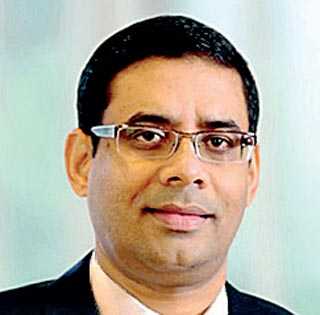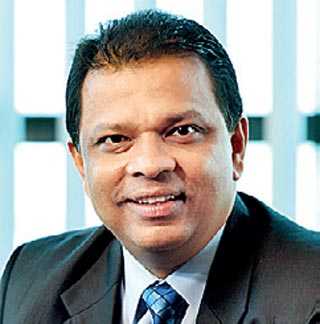Monday Apr 07, 2025
Monday Apr 07, 2025
Tuesday, 23 February 2021 01:21 - - {{hitsCtrl.values.hits}}
 |
| Chairman Dinesh Weerakkody |
 |
| MD/CEO Jonathan Alles
|
Hatton National Bank PLC (HNB) said yesterday it demonstrated resilience and an unwavering focus on sustainable business performance as it posted Rs. 13.7 billion in Group Profit After Tax during 2020, a year laden with unprecedented circumstances and challenges. Bank level Profit After Taxes amounted to Rs. 11.5 billion.
Commenting on the performance, HNB Chairman Dinesh Weerakkody stated: “2020 has been a year unlike any other in recent memory as the COVID-19 Pandemic transformed the socioeconomic landscape dramatically, elevating uncertainty and risks at every level, both locally and globally. We proved our ability to adjust rapidly as we leveraged technology and adapted to the new normal, sharing the responsibility to stay safe as well as keep our communities safe and empowered.”
He added: “Even before the onset of the pandemic, our economy was adversely affected due to the Easter Sunday bombings of 2019. The onset of the pandemic aggravated our economic woes, straining cash flows, at individual, entity and national levels while paving the way for a disruptive transformation that vaulted us to a new era of exciting possibilities.
“At HNB, we have reset our agenda and will continue to do so going forward, embedding the new-found speed and agility into our ways of working and identify the best ways to respond, making sure we sustain such best practices in our operations. Unlike ever before, we, as a leading bank, have a crucial role to play in the task of restoring and supporting the livelihoods of our communities.”
Managing Director/CEO Jonathan Alles said: “In the wake of the COVID-19 pandemic, we reprioritised our focus to ensure that we navigate the uncertainties and risks effectively to safeguard the interests of all our stakeholders. Health and safety, business sustainability and supporting the customers in need were at the core.”
He added: “Our dedicated team of 4,800+ members rallied around together to provide the much needed financial relief and banking needs despite lockdowns. During the first phase we provided debt moratoria to customers covering approximately 40% of our loan book.
“With lockdowns being limited to few localities during the second wave of the pandemic and most industries recommencing their operations, the moratoria extended under the second phase has reduced to approximately 15% of the loan book which is a positive sign for the economy.
We also extended working capital finance of over Rs. 24 billion to affected sectors at concessionary interest rates under the CBSL relief scheme and set up a Rs. 5 billion fund through our own funds to support SMEs. A microfinance grant of Rs. 20 million was also distributed among 200 needy customers. Apart from financial relief we facilitated customer transactions without any disruption, through our branches, digital channels and payment solutions such as SOLO, MOMO, IPG and Appigo.”
The accommodative monetary policy adopted by the CBSL to drive economic growth saw AWPLR dropping sharply by over 400bps during the year. Nevertheless, the demand for credit did not pick up as anticipated due to prevailing uncertainty. As a result, the bank’s interest income declined by 10% YoY to Rs. 103.9 billion. The outstanding growth of approx. Rs. 99 billion in CASA deposits during the year coupled with low interest rates eased pressure on interest costs to a certain extent.
However, Net Interest Income of the bank dropped by 9% YoY to Rs 44.7 billion. Net fee income declined more steeply by 16% YoY to Rs. 7.5 billion as Import restrictions, depressed demand in export markets, lower card spends, particularly during the first wave of COVID, the slow-down in economic activity as well the directions imposed by CBSL to waive off certain fees until September 2020 collectively impacted this channel of income.
Lower swap costs and volumes along with exchange rate movements during the year lead to an improvement of Rs. 2.2 billion in net trading gains compared to 2019. The bank also recorded a capital gain of Rs. 1.1 billon through disposal of Government securities during the final quarter of 2020.
A facility of over Rs. 11.5 billion to an SOE which was classified as NPA in 2019 was regularised during the last quarter of 2020. This together with the bank’s concerted efforts on improving asset quality enabled HNB to record a marked improvement in its NPA ratio to 4.3% from 5.9% reported as at end of 2019 despite the stressed market conditions.
Nevertheless, the bank made prudent provisions taking in to consideration factors such as elevated risks in certain sectors and the deterioration in economic conditions. Furthermore, the bank recognised substantial impairment charges on account of its investments in dollar denominated Government securities due to the sovereign downgrade by rating agencies. These factors resulted in provisions increasing by 58% to Rs. 15.3 billion for the year ended December 2020.
Given the negative impact on the top line the bank focused on cost optimisation opportunities. This enabled the bank to record a drop of Rs 1.6 billion in total operating expenses compared to the previous year. Accordingly, the Cost to Income ratio improved to 39.3% despite the drop in operating income, without any downsizing or compromise on staff salaries.
The removal of debt repayment levy and NBT proved to be timely as the banking sector stepped into support the economic revival. Profit Before Tax (PBT) amounted to Rs. 15.1 billion while the PAT of Rs. 11.5 billion was 18.3% YoY lower than that reported in 2019.
The bank’s asset base expanded by Rs. 167 billion to Rs. 1.3 trillion while the loan book recorded a moderate growth of 5.5%, The CASA ratio improved to 40% from 35% recorded a year ago, as CASA deposits grew by 35% to Rs. 384 billion. The funding side of the balance sheet was also bolstered by the $ 60 million long term loan from PROPARCO, the French Development Agency.
This borrowing will be utilised to fund SME growth in 2021. Despite the substantial moratoria granted, the liquidity levels remained strong with LAR at 39.6% and LCR at 290.3% against the regulatory requirement of 20% and 90% respectively. HNB is also among the best capitalised banks with Tier I and Total Capital Adequacy Ratios of 14.73% and 17.98% respectively well above the statutory requirement.
Insurance and Investment Banking led contributions from subsidiaries as the HNB Group made Profit Before Taxes of Rs. 17.6 billion. Total Group assets rose by 14.5% YoY to Rs. 1.4 trillion. The bank declared a final dividend of Rs 8.00 per share consisting of a cash dividend of Rs. 4.50 and a scrip dividend of Rs. 3.50 per share.
Alles further stated that “through our strategic refocus we were able to demonstrate resilience, strength and stability in a year that posed unprecedented challenges. I would like to extend my heartfelt gratitude to the entire team for their untiring efforts and dedication in an extremely difficult year and to all other stakeholders for continuing to place their trust and confidence in us”.
He added: “With vaccines being administered among the general public currently we look at the future with hope and optimism. As the ‘partner in progress’ for generations of Sri Lankans, and our roots in serving micro, small and medium enterprises, we have strengthened our structures, systems and processes internally to play a catalytic role in the resurgence of our nation.”
Discover Kapruka, the leading online shopping platform in Sri Lanka, where you can conveniently send Gifts and Flowers to your loved ones for any event including Valentine ’s Day. Explore a wide range of popular Shopping Categories on Kapruka, including Toys, Groceries, Electronics, Birthday Cakes, Fruits, Chocolates, Flower Bouquets, Clothing, Watches, Lingerie, Gift Sets and Jewellery. Also if you’re interested in selling with Kapruka, Partner Central by Kapruka is the best solution to start with. Moreover, through Kapruka Global Shop, you can also enjoy the convenience of purchasing products from renowned platforms like Amazon and eBay and have them delivered to Sri Lanka.
Discover Kapruka, the leading online shopping platform in Sri Lanka, where you can conveniently send Gifts and Flowers to your loved ones for any event including Valentine ’s Day. Explore a wide range of popular Shopping Categories on Kapruka, including Toys, Groceries, Electronics, Birthday Cakes, Fruits, Chocolates, Flower Bouquets, Clothing, Watches, Lingerie, Gift Sets and Jewellery. Also if you’re interested in selling with Kapruka, Partner Central by Kapruka is the best solution to start with. Moreover, through Kapruka Global Shop, you can also enjoy the convenience of purchasing products from renowned platforms like Amazon and eBay and have them delivered to Sri Lanka.